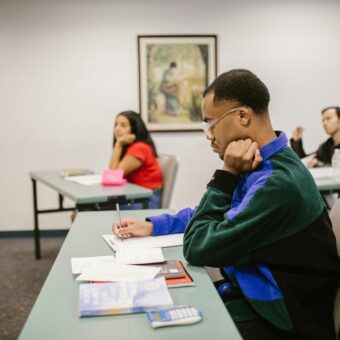
“80% of university students report high stress levels, with over 40% showing signs of burnout.” Aristovnik et al., 2020
Burnout in academia is no longer rare, it is fast becoming a defining feature of both student and staff experience. While commitment is often celebrated, the cost is frequently ignored. Many of us in higher education feel that being endlessly available and productive is simply expected. But at what cost?
One literary figure, Honoré de Balzac, offers a surprisingly relevant reflection. The 19th-century French novelist was famous for writing up to 18 hours a day, driven by an excessive coffee habit and fierce ambition (Robb, 1994). While his dedication resulted in a vast literary legacy, it also contributed to his deteriorating health and early death at age 51. Balzac’s extreme lifestyle serves as a mirror for today’s academic world, where relentless productivity often overshadows wellbeing.
Balzac’s work resonates today not just for its content but for the pressure-filled context in which it was produced. For example, Lost Illusions (Balzac, 1837) introduces Lucien Chardon, a young man full of promise who eventually buckles under academic and societal expectations. This character reflects modern students at risk of burnout bright, ambitious, but stretched beyond reason. Likewise, in The Unknown Masterpiece (Balzac, 1831), the artist Frenhofer becomes obsessed with perfection to the point of destroying his own work much like students or lecturers who compromise their health in pursuit of impossible standards.
Lecturers: Balance Over Burnout
- Set clear boundaries around availability and avoid glorifying after-hours work. Modelling balance reinforces a healthier academic culture.
- Demonstrate prioritisation and self-care so students understand that effective learning includes managing wellbeing.
- Encourage open dialogue about workload, deadlines, and capacity. Transparency supports trust and prevents burnout.
Students: Structure for Success
- Don’t equate busyness with productivity. Focus on meaningful progress, not just staying occupied.
- Break tasks into smaller goals and consider using techniques like the Pomodoro Method: work for 25 minutes, then take a 5-minute break. This can improve concentration and reduce cognitive fatigue.
- Ask for help when needed. Growth requires support, not suffering. No one thrives in isolation.
Time management models such as the Eisenhower Matrix or Macan’s (1994) time management theory can assist in distinguishing urgent tasks from important ones, enabling strategic planning and reducing panic. These approaches aren’t just academic tools they are survival strategies in a demanding environment.
Weekly planning, peer collaboration, and short reflective exercises helped me become more intentional with my time and energy. Using platforms like Trello, Google Calendar, and Notion empowered me to visualise deadlines and progress. The key wasn’t doing more but doing better.
Academia should embrace a culture of sustainable ambition.
Our mission in education is not only to deliver knowledge, but also to model how to thrive intellectually and personally. The obsessive pursuit of perfection, while romanticised in figures like Balzac, should not become the benchmark for academic excellence.
So, what kind of academic culture are we building for our students and for ourselves?
Let it be one that values quality over quantity, health over heroics, and progress over perfection.
References
- Aristovnik, A., Keržič, D., Ravšelj, D., Tomaževič, N., & Umek, L. (2020). Impacts of the COVID-19 pandemic on life of higher education students: A global perspective. Sustainability, 12(20), 8438. https://doi.org/10.3390/su12208438
- Balzac, H. de (1831). The Unknown Masterpiece. Paris: Charles-Béchet.
- Balzac, H. de (1837). Lost Illusions. Paris: Delloy.
- Macan, T. H. (1994). Time management: Test of a process model. Journal of Applied Psychology, 79(3), 381–391. https://doi.org/10.1037/0021-9010.79.3.381
- Robb, G. (1994). Balzac: A Biography. New York: W. W. Norton & Company.
